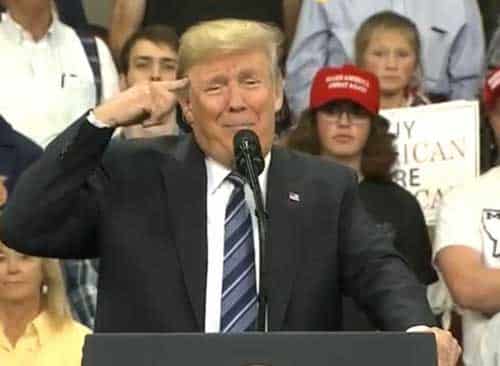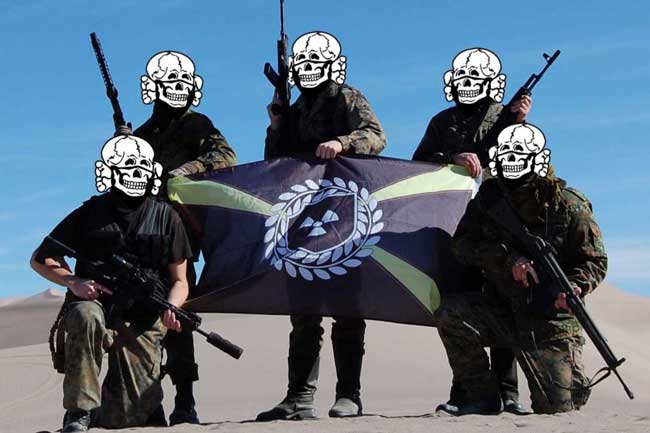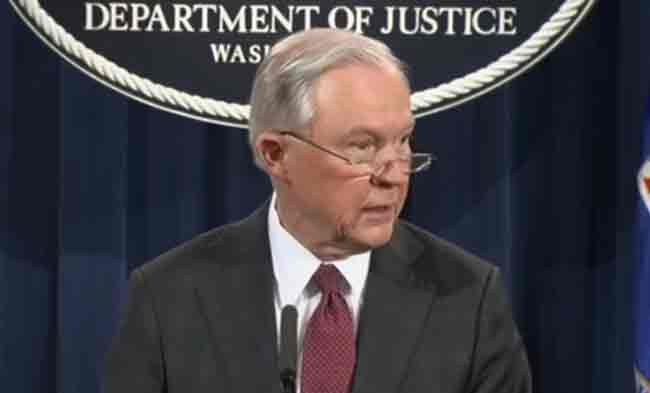
An ongoing effort by many within the Republican Party to reframe the January 6, 2021, attack on the U.S. Capitol as an act of patriotism reached a peak, of sorts, during former President Donald Trump’s first large-scale reelection campaign rally last weekend.
At the beginning of his appearance, Trump stood on the stage with his hand over his heart, as speakers blared out a version of the national anthem recorded by a choir made up of people convicted of various charges related to the attack. On a screen behind the president, images of the Capitol during the Jan. 6 assault were displayed to a cheering crowd.
The song, recorded by the “J6 Prison Choir,” features Trump reciting the Pledge of Allegiance over the music, and concludes with chants of “U.S.A.! U.S.A.!,” which were echoed by the estimated 10,000 to 15,000 people who came to see Trump at the outdoor event in Waco, Texas, on Saturday.
In his remarks, Trump railed against what he described as the “weaponization” of law enforcement against him and his supporters. He pledged that if he is reelected in 2024, “You will be vindicated and proud and the thugs and criminals who are corrupting our justice system will be defeated, discredited and totally disgraced.”
Change of tune
The veneration of the attack on display at the Trump rally shows how far some segments of the GOP have come in the more than two years after a violent mob stormed the Capitol in an effort to prevent Congress from certifying President Joe Biden’s election victory in 2020.
In the immediate aftermath of the assault, condemnation of the attack was bipartisan, with some Republicans — including current House Speaker Kevin McCarthy — blaming Trump for inciting the crowd. In the intervening two years, however, many in the GOP have simply gone silent on the issue, while others have actively worked to rewrite the narrative, downplaying the violence of the day and claiming that the law enforcement effort to charge perpetrators amounts to political persecution.
More recently, efforts have been made to characterize the events of that day as fundamentally peaceful. McCarthy made thousands of hours of video taken on the grounds of the Capitol on Jan. 6 available to conservative Fox News host Tucker Carlson, who selectively aired segments on his program that suggested the protests were nonviolent.
Detached from reality
In reality, while not all Jan. 6 participants resorted to violence, videos of the event taken by participants, law enforcement and news organizations captured the raw brutality of the assault, which took place over the course of several hours. Demonstrators used chemical sprays and improvised weapons to break through police barricades, forcing bloodied law enforcement officers to fall back from the onslaught.
The attack left dozens of police officers injured, some severely. At least five people died during the assault or in its aftermath.
Several hours into the assault, President Trump urged his supporters to peacefully exit the Capitol. He has since denied inciting the protesters to violence.
Kurt Braddock, an assistant professor of communication at American University who researches the language extremist groups use to radicalize their audiences, said that in some respects the way Trump is rewriting history is typical.
“It does not strike me as terribly surprising,” he told VOA in an email exchange. “One of the cornerstones of Trump’s communication strategy has been to deny objective reality and to replace it with one that benefits him. That seems to be what he is doing here.”
Braddock added, “I think it is simply an extension of what he has been doing for six or seven years now — recasting an incriminating history such that he is a patriotic hero rather than someone responsible for an attack against the U.S. itself. Unfortunately, his followers are more than happy to accept the reality he creates.”
Echoes of fascism
Experts on the topic of extremism and political violence said that the Trump movement’s embrace of the attack and valorization of its perpetrators has disturbing historical parallels.
“It’s classic fascism,” said Jason Stanley, a professor of philosophy at Yale University and the author of the book “How Fascism Works.”
Stanley pointed out that a foundational moment in the development of the Nazi Party in Germany was a failed coup in 1923, known as the “Beer Hall Putsch.” In a violent confrontation with police, 16 Nazis were killed. They would later be venerated by the party as “blood martyrs,” and the date of the coup attempt in which they participated was celebrated annually.
“It’s all very textbook,” Stanley told VOA. “You take the people who are trying to overthrow the government, in a violent putsch for the fascist leader, and you make them into heroes. They’re your Stormtroopers. That’s the thing about history — it instructs.”
Trump’s limited success
Rachel Kleinfeld, a senior fellow at the Carnegie Endowment for International Peace and an expert on political violence, told VOA that while Trump’s effort to celebrate the Jan. 6 attack is troubling, it remains important to retain perspective.
The former president, she said, has called for other protests to take place over his possible indictment in New York on charges that he illegally used campaign funds to buy the silence of an adult film star who claims the two had an affair. Few protests have occurred, Kleinfeld noted, and a recent rally to support him in New York, organized by the Young Republicans, attracted more reporters than participants.
Like other populist leaders, Kleinfeld said, Trump craves the media spotlight. She said it is important that the media be judicious about the kind of coverage it provides.
“We’ve seen that in a lot of other countries where populist authoritarians come back, or that style of leadership comes back because the media finds more fun, frankly, and gets more viewership than normal, boring politicians,” she said. “We’re seeing that in America, too. But of course, he is normalizing violence and other Republican Party members are not calling him out for it. So that part is real.”
Braddock, of American University, said that Trump’s apparent approval of the violence on January 6 might result in more attacks in the future.
“When violence is championed by a leader that people admire, it becomes normalized,” Braddock wrote. “That is, people begin to think that violence is not only something that’s acceptable, but expected. That is the real danger; when his followers think that he would approve of their actions, it becomes more likely that they will engage in that action. He is creating an atmosphere where past attacks are retroactively justified, increasing the chances of future attacks.”
Waco history
Trump’s choice of Waco as the site of his rally on Saturday was a clear, if not necessarily intentional, callback to a moment many in the far right in the U.S. consider important for their movement.
The town was the site of a 1993 standoff between federal law enforcement agencies and a religious sect known as the Branch Davidians. A gun battle and subsequent multiweek siege of the group’s compound ended with a massive assault on the compound, which triggered a devastating fire.
The events in Waco ended in the death of four federal agents and 82 Branch Davidians. The siege has become a touchstone for the hard right in the U.S., held up as an example of the excessive power of the federal government.
[content id=”52927″][content id=”79272″]








